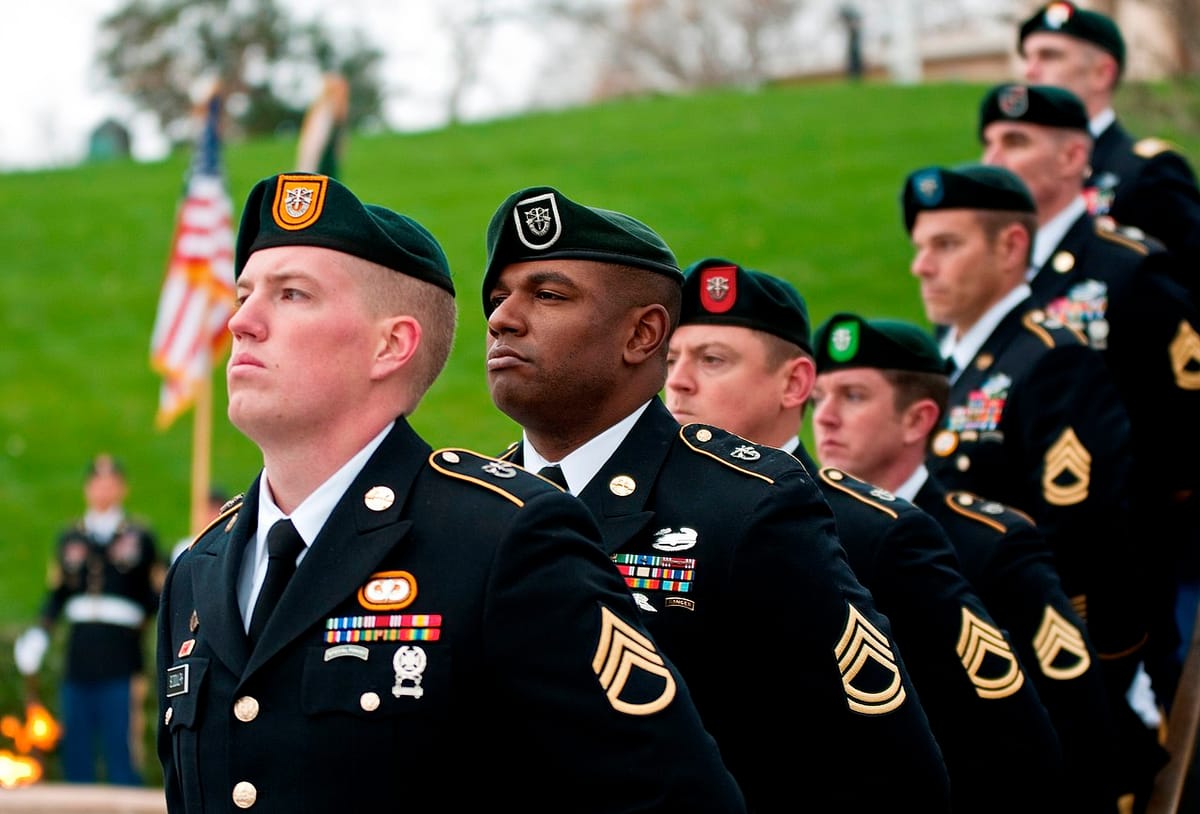The Rising Relevance of Green Berets in the Post-GWOT Era: Why They Are Outpacing Tier 1 Special Forces
As the U.S. military shifts from counterterrorism to great power competition, Green Berets are becoming more relevant due to their expertise in unconventional warfare, influence operations, and partner nation capacity-building

TL;DR
As the Global War on Terror (GWOT) draws to a close, the U.S. military is shifting focus towards great power competition with adversaries like China and Russia. This transition is driving a reevaluation of the roles within Special Operations Forces (SOF). While Tier 1 units like Delta Force and SEAL Team 6 have dominated counterterrorism missions, the U.S. Army Special Forces, known as Green Berets, are becoming increasingly relevant. Their skills in unconventional warfare, foreign internal defense, and capacity-building are more suited to the complexities of modern geopolitical challenges, making them indispensable in the new era of strategic competition.
Introduction
The U.S. military’s priorities are shifting. As the Global War on Terror (GWOT) comes to a close, the focus is moving away from counterterrorism operations toward confronting near-peer competitors like China and Russia. This pivot has significant implications for U.S. Special Operations Forces (SOF). For over two decades, elite Tier 1 units like Delta Force and SEAL Team 6 were the go-to forces for high-stakes counterterrorism missions. However, the strategic environment is changing. In the post-GWOT world, the unique capabilities of the Green Berets are becoming more relevant, positioning them for a more prominent role in the U.S. defense strategy.
1. Strategic Reorientation from Counterterrorism to Great Power Competition
The Pentagon is increasingly prioritizing great power competition over counterterrorism. This shift involves countering China's expansion in the Indo-Pacific and deterring Russia’s influence in Eastern Europe. These strategic imperatives require skills beyond the kinetic raids and targeted strikes that Tier 1 units specialize in. Instead, the emphasis is on influence, deterrence, and shaping the strategic environment—missions that align more closely with the Green Berets’ expertise.
Green Berets excel in unconventional warfare, which involves working with indigenous forces, conducting psychological operations (PSYOP), and executing foreign internal defense (FID). This versatility makes them invaluable in an era where proxy conflicts and gray zone operations are more common than traditional warfare. The focus on empowering partner nations to defend themselves aligns with the U.S.'s goal of minimizing direct military engagement while still maintaining influence.
2. Unconventional Warfare: The Green Berets' Core Strength
Green Berets are uniquely trained to operate in environments where conventional forces cannot. Unlike Tier 1 units, which are optimized for direct action missions such as high-value target raids, the Green Berets are skilled in unconventional warfare, which includes guerrilla tactics, sabotage, and working behind enemy lines to destabilize adversaries.
Their ability to operate autonomously in politically sensitive environments, with minimal support, makes them ideal for missions in contested regions. For example, in the Baltic states and Eastern Europe, Green Berets are engaged in training local forces to resist potential Russian aggression. Their work in the Indo-Pacific involves building the capacities of regional allies like the Philippines to counter China’s growing influence.
The U.S.'s strategic pivot to the Indo-Pacific necessitates a soft power approach that integrates military capabilities with diplomatic efforts. Green Berets' deep understanding of local cultures, languages, and geopolitics makes them effective soldier-diplomats who can engage with foreign partners to build trust and cooperation.
3. Building Partner Nation Capacities: A Force Multiplier in Modern Conflict
One of the most critical roles of the Green Berets is to build the defense capabilities of allied nations, a mission that has taken on new importance in the face of great power competition. The Foreign Internal Defense (FID) mission, which focuses on training, advising, and assisting foreign militaries, allows the U.S. to extend its influence indirectly.
Green Berets have played pivotal roles in regions like Africa, where they’ve trained local forces to counter extremist groups. In Eastern Europe, they have been instrumental in bolstering the capabilities of NATO allies to deter Russian aggression. These missions are not just about tactical training; they are about fostering long-term strategic partnerships that can serve as a bulwark against adversarial influence.
In the era of great power competition, where direct military confrontation is often avoided, these capacity-building missions are essential. By strengthening the self-defense capabilities of allies, the U.S. can exert influence without the need for large-scale military deployments.
4. The Green Berets’ Role in Psychological Operations and Civil Affairs
In the modern battlefield, influence is as crucial as firepower. The ability to shape narratives, sway public opinion, and undermine adversaries through non-kinetic means is becoming increasingly important. Green Berets are trained in psychological operations (PSYOP) and civil affairs, enabling them to conduct influence campaigns that can alter the strategic landscape without resorting to force.
Tier 1 units, while highly effective in surgical strikes, do not possess the same depth in influence operations as the Green Berets. For example, in Eastern Europe, Green Berets have been engaged in countering Russian disinformation campaigns by strengthening the media capabilities of allied nations and providing training in information security. This ability to operate in the information domain is critical in today’s conflicts, where narratives can be as decisive as military victories.
5. Adapting to the Era of Hybrid Warfare
Modern warfare is increasingly fought in the gray zone, where cyber attacks, information warfare, and economic coercion are used to achieve strategic objectives without triggering open conflict. Green Berets are well-suited to operate in this environment due to their expertise in unconventional warfare. Their training allows them to respond flexibly to hybrid threats, which often involve a mix of state and non-state actors.
While Tier 1 units are optimized for short-term, high-impact missions, the Green Berets’ approach is more long-term and strategic. They focus on building sustainable capabilities within partner nations, thereby creating a resilient network of allies capable of countering adversarial influence. This is particularly important in regions like Africa and Southeast Asia, where China’s Belt and Road Initiative is expanding its economic and political influence.
6. Countering the Influence of Near-Peer Competitors
Green Berets are increasingly involved in efforts to counter China’s growing influence in regions like Africa, Latin America, and Southeast Asia. These areas are critical battlegrounds where China is using economic investments and political leverage to expand its sphere of influence. By working closely with local governments and militaries, Green Berets can help these nations resist Chinese pressure while promoting U.S. interests.
For instance, in Africa, Green Berets are training local forces not only in counterinsurgency but also in cybersecurity and intelligence gathering to protect against Chinese surveillance and information operations. This comprehensive approach extends beyond traditional military training, focusing on building capabilities that allow nations to safeguard their sovereignty.
7. Addressing Emerging Threats Beyond the Traditional Battlefield
The threat landscape has evolved beyond physical battlefields to include cyber warfare, space operations, and influence campaigns. Green Berets are expanding their skill sets to include training in cyber operations, information security, and counterintelligence. Their focus on civil-military cooperation and psychological operations positions them as key players in addressing these emerging threats.
In contrast, Tier 1 units remain focused on short-term, high-risk missions that require rapid, decisive action. While these capabilities are still critical, the Green Berets' broader mission set and adaptability to different environments make them more relevant to the challenges posed by great power competition. The ability to operate in politically sensitive areas, build long-term alliances, and influence adversarial strategies is what sets the Green Berets apart in the post-GWOT era.
Conclusion: The Future of Green Berets in U.S. Strategy
As the U.S. military transitions from counterterrorism to great power competition, the relevance of Green Berets is set to grow. Their focus on unconventional warfare, influence operations, and capacity-building aligns with the current strategic landscape where indirect influence often outweighs direct military engagement. Green Berets are not just fighters; they are diplomats, trainers, and influencers who can shape the outcome of conflicts before they escalate.
In the coming years, as geopolitical tensions rise, the Green Berets will play an increasingly critical role in maintaining U.S. influence and ensuring the stability of key regions. Their ability to adapt to new threats and operate in challenging environments makes them indispensable in a world where military power is measured not just by strength, but by strategic influence and adaptability.
